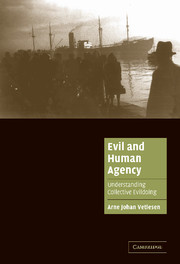Book contents
- Frontmatter
- Contents
- Preface
- A note on the cover image
- Introduction
- 1 The ordinariness of modern evildoers: a critique of Zygmunt Bauman's Modernity and the Holocaust
- 2 Hannah Arendt on conscience and the ‘banality’ of evil
- 3 The psycho-logic of wanting to hurt others: An assessment of C. Fred Alford's work on evil
- 4 The logic and practice of collective evil: ‘ethnic cleansing’ in Bosnia
- 5 Responses to collective evil
- 6 A political postscript: globalization and the discontents of the self
- References
- Index
- Evil and human agency
4 - The logic and practice of collective evil: ‘ethnic cleansing’ in Bosnia
Published online by Cambridge University Press: 10 December 2009
- Frontmatter
- Contents
- Preface
- A note on the cover image
- Introduction
- 1 The ordinariness of modern evildoers: a critique of Zygmunt Bauman's Modernity and the Holocaust
- 2 Hannah Arendt on conscience and the ‘banality’ of evil
- 3 The psycho-logic of wanting to hurt others: An assessment of C. Fred Alford's work on evil
- 4 The logic and practice of collective evil: ‘ethnic cleansing’ in Bosnia
- 5 Responses to collective evil
- 6 A political postscript: globalization and the discontents of the self
- References
- Index
- Evil and human agency
Summary
Introduction
In relation to the three preceding chapters, this chapter marks a twofold shift. It shifts the emphasis from the theoretical to the empirical, concentrating on specific historical cases; and it shifts the emphasis from individual to collective evil.
However, these shifts should not be understood in an absolute sense. Just as I have been drawing on empirical material (mainly from the Holocaust) to develop my criticisms of Zygmunt Bauman's and Hannah Arendt's positions, I shall in the present chapter, as well as in the next, analyse the historical events referred to by drawing on theoretical work on evil. Theory and practice mutually illuminate each other – and I intend them to mutually question each other too, in a truly critical fashion.
In the two historically oriented chapters now following, I shall make use of the insights gained in the chapters where I assessed the contributions of Bauman, Arendt, and Alford. But I shall not do so in a pedantic manner. I am not interested in bringing all three positions to bear on all – or nearly all – the issues thrown up by the historical material at hand. Instead I will employ concepts and insights developed earlier in the book for the chief purpose of illuminating the issues that will prove to be the singularly most challenging, and disturbing, ones. Among these, the issue of proximity will occupy centre stage.
- Type
- Chapter
- Information
- Evil and Human AgencyUnderstanding Collective Evildoing, pp. 145 - 219Publisher: Cambridge University PressPrint publication year: 2005

